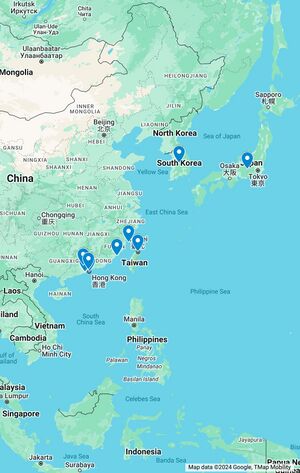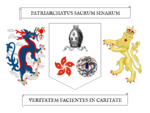Patriarchate of the Holy China
Patriarchate of the Holy China Patriarchatus Sacrum Sinarum 神聖中華宗主教國 | |
|---|---|
| Motto: Veritatem Facientes in Caritate (Latin) Speaking the Truth in Love | |
| Anthem: Patriarchal Anthem of the Holy China | |
| Status | Active |
| Capital and largest city | Capitale Sciiamchiamensis |
| Official languages | Chinese, English, Latin |
| Ethnic groups | Chinese |
| Religion | Roman Catholic |
| Government | Prince-Bishopric |
• Patriarch of the Holy China Primate of Sciiamchiamensis, Macaonensis, Southern Canton and Ilha Formosa Prelate of Goryeo and Nippon Grand Prior of the Most Venerable Sovereign Order of St. Cyril of the Holy China | Cyrillus Mariae Poon |
| Legislature | The Patriarchal Chancery The Patriarchal Chapter of Canons of the Cathedral of St. Cyril |
| Establishment | 10 May 2023 |
| Time zone | Hong Kong Standard Time (UTC+8) Korea and Japan Standard Time (UTC+9) |
The Patriarchate of the Holy China (Chinese: 神聖中華宗主教國 / Latin: Patriarchatus Sacrum Sinarum) is a self-declared sovereign micronation state based in the East Asian region. Its territory is mainly comprised of the Provinces of Macaonensis, Southern Canton and Ilha Formosa, and the Territorial Prelature of Goryeo and Nippon. The capital and the largest city of the Patriarchate of the Holy China is Capitale Sciiamchiamensis.
Established on 10th May 2023, the Patriarchate of the Holy China is the first and only "Prince-Bishopric" nation in the Asian Region. In ancient times, the Prince-Bishop not only has the power in the Church but also the power of civil and sovereignty rule.
Brief History
In the year 34 A.D., 3 disciples of Jesus Christ came to China, then a few years later the Virgin Mary appeared to the Emperor of China and the Emperor was converted to Catholicism. At that time, China is the First Catholic Nation. It was earlier than the Holy Roman Empire. Although the Pope remains in the Vatican, China has the most significant place in the Catholic World.
The Patriarchate of the Holy China was officially established on 10th May 2022, which is the first and only "Prince-Bishopric" in the Asian Region. In ancient times, the Prince-Bishop not only has the power in the Church but also the power of civil rule.
The Patriarch of the Holy China
The current Patriarch of the Holy China is His Most Beatitude Cyrillus Mariae Poon. He was ordained and installed as the First Patriarch of the Holy China and Primate of Sciiamchiamensis, Macaonensis, Southern Canton and Ilha Formosa on 10th May 2023, with special permission granted by the Holy See in the Vatican.
He is also the incumbent Grand Prior of the Most Venerable Sovereign Order of St. Cyril of the Holy China.
On 11th March 2024. After the establishment of the Territorial Prelature of Goryeo and Nippon, he was granted to title of "Prelate of Goryeo and Nippon".
Patron Saints
Here is the list of the Patron Saints of the Patriarchate of the Holy China
- Our Lady of China
- Our Lady of Fatima
- St. Cyril and St. Methodius
- St. Cyril of Jerusalem
- St. Cyril of Alexandra
- St. Josemaria Escriva
- St. John Paul II
- St. Pius X
- Blessed Alvaro del Portillo
- Blessed Carlo Acutis
Legislature
The Patriarchal Chancery
The legislative power is held by the Members of the Patriarchal Chancery. Which they convene regularly to pass laws, establish domestic and foreign policies, appoint new members of the chancery, and discuss and approve plans from the Patriarch.
The Patriarchal Chapter of Canons of the Cathedral of St. Cyril
The Patriarchal Chapter is an integral part of the Cathedral of St. Cyril, as outlined in the Statutes of the Patriarchal Chapter. According to these statutes, approximately 10 Canons are appointed by the Patriarch to serve in the Chapter.
Once appointed and installed, the Canons hold their positions until they reach the age of 75. At that point, they are requested to offer their resignation from the Patriarchal Chapter to the Patriarch. Once a Canon has resigned, they are referred to as a Canon Emeritus.
In accordance with the general law of the Roman Catholic Church, the primary role of the Patriarchal Chapter is to celebrate the more solemn liturgical functions within the Cathedral. This includes important ceremonies and events that require a higher level of solemnity.
Moreover, in the context of the Patriarchate of the Holy China, the Patriarchal Chapter also serves as the College of Consultors. This means that the members of the Chapter provide advice and guidance to the Patriarch on specific issues that are outlined in the law.
Additionally, the Patriarch has the authority to appoint Honorary Canons who are not part of the Chapter. These Honorary Canons, while not serving in the Chapter, are granted the title of 'Very Reverend Canon' and are permitted to wear the prescribed canonical dress.
The presence of the Patriarchal Chapter within the Cathedral of St. Cyril and the Patriarchate of the Holy China plays a crucial role in upholding the traditions and responsibilities of the Church. The Canons, both active and emeritus, along with the Honorary Canons, contribute to the solemnity of liturgical functions and provide valuable counsel to the Patriarch.
The Order of St. Cyril
The Order of St. Cyril (Chinese: 聖濟利祿騎士團 / Latin: Ordo Sancti Cyrilli), officially the Most Venerable Sovereign Order of St. Cyril of the Holy China (Chinese: 德望崇隆的神聖中華聖濟利祿騎士團 / Latin: Ordo Sancti Cyrilli Sacrae Sinensis Venerabilissimus), is a Roman Catholic Chivalric Order of Knighthood and serves as the official Department of Military of the Patriarchate of the Holy China. The current Grand Prior of the Order is the Patriarch of the Holy China, His Most Beatitude Cyrillus Mariae Poon.
As a Military Order, the Order of St. Cyril follows a structure of ranks that aligns with European chivalric customs. These ranks are bestowed to recognize outstanding service or achievement. The process of promotion within the Order is based on individual accomplishments and requires the approval of the Grand Prior.
Active and dedicated members of the Order have the opportunity to ascend through the ranks, with the ultimate distinction of Knighthood or Damehood being the highest honor bestowed upon those who selflessly serve the Order. Members who demonstrate exceptional dedication and commitment may be promoted to higher ranks as they progress in their journey.
In addition to promotions, members of the Order may also be decorated for noteworthy achievements or exceptional merit. These decorations serve as further recognition of their contributions to the Order and their demonstration of the core values it upholds.
The structure of ranks and decorations within the Order of St. Cyril highlights the importance of service, achievement, and dedication to the ideals of chivalry. Through promotions and decorations, the Order recognizes and honors its members for their commitment to selflessly serve and uphold the principles of the Order.
The Ranks of the Order of St. Cyril
- GPStC (Grand Prior)
- GCStC (Grand Commander)
- KStC (Knights of Justice)
- DStC (Dames of Grace)
- OStC (Officer)
- MStC (Member)
- MStC Post. (Postulant Member)
Administrative Regions

The current administrative regions of the Patriarchate of the Holy China are divided into 3 levels:
Level 1: Capital
Capitale Sciiamchiamensis
- Chinese: 香江京
- The Capital and the Largest City
- Surrounding with Hong Kong Island District, Kowloon District and New Territories District.
Level 2: Provinces
Province of Macaonensis
- Chinese: 濠江行省
- Surrounding with Macau Peninsula, Taipa Island and Coloane Island.
Province of Southern Canton
- Chinese: 南粵行省
- Surrounding with Shenzhen city and Guangzhou city.
Province of Ilha Formosa
- Chinese: 福爾摩沙行省
- Surrounding with Taiwan Island, Matsu Island and Kinmen Island.
Level 3: Territorial Prelature
Territorial Prelature of Goryeo and Nippon
- Chinese: 高麗及東瀛自治監督區
- Surrounding with Korea and Japan Peninsula
Foreign Relations
Recognized Nations, Cities and Micronations
Unrecognized Nations, Cities and Micronations
Culture
The culture of the Patriarchate of the Holy China is mainly based on Roman Catholic values and various celebrations.
Language
Cantonese and English is the everyday language in the Patriarchate of the Holy China everyone in the nation speaks it. However, Latin is used sometimes in some legal documents, as it is the second language of the nation.
Holidays and National Events
- January 1 -- New Years Day
- January 6 -- Epiphany
- Wednesday in the seventh week before Easter -- Ash Wednesday
- February 14 -- Feast Day of St. Cyril and St. Methodius
- March 18 -- Feast Day of St. Cyril of Jerusalem
- Sunday before Easter Sunday -- Palm Sunday
- Thursday before Easter Sunday -- Maundy Thursday
- Friday before Easter Sunday -- Good Friday
- The Thursday 40 days after Easter -- Ascension of Jesus Christ
- Seventh Sunday after Easter -- Pentecost
- Second Sunday of May -- Feast Day of Our Lady of China
- May 10 -- Foundation Day of the Patriarchate of the Holy China
- May 12 -- Feast Day of Blessed Alvaro del Portillo
- May 13 -- Feast Day of Our Lady of Fatima
- 60 days after Easter -- Corpus Christi
- June 14 -- Patriarch's Birthday
- June 26 -- Feast Day of St. Josemaria Escriva
- June 27 -- Feast Day of St. Cyril of Alexandra
- August 15 -- Ascension of The Blessed Virgin Mary
- August 21 -- Feast Day of St. Pius X
- October 2 -- Feast Day of the Guardian Angle
- October 12 -- Feast Day of Blessed Carlo Acutis
- October 22 -- Feast Day of St. John Paul II
- November 1 -- All Saints Day
- November 2 -- All Souls Day
- December 24 -- Nativity of Jesus Christ
- December 25 -- Christmas Day
Religion
The official religion in the Patriarchate of the Holy China is Roman Catholicism, however, residents are not required to practice the faith. Much of the culture in the Patriarchate of the Holy China is inspired, based on, and due to practices of many values of the Roman Catholic Church.
See also
- The Most Venerable Sovereign Order of St. Cyril of the Holy China
- Territorial Prelature of Goryeo and Nippon
- Patriarchal Anthem of the Holy China

